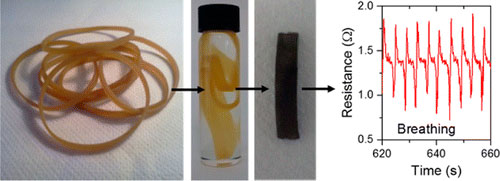| Posted: Aug 19, 2014 |
Graphene rubber bands could stretch limits of current healthcare, new research finds
|
|
(Nanowerk News) New research published today in the journal ACS Nano ("Sensitive, High-Strain, High-Rate Bodily Motion Sensors Based on Graphene–Rubber Composites") identifies a new type of sensor that can monitor body movements and could help revolutionise healthcare.
|
 |
| Monitoring of human bodily motion requires wearable sensors that can detect position, velocity and acceleration. They should be cheap, lightweight, mechanically compliant and display reasonable sensitivity at high strains and strain rates. No reported material has simultaneously demonstrated all the above requirements. This work describes a simple method to infuse liquid-exfoliated graphene into natural rubber to create conducting composites. (Image: © ACS)
|
|
Although body motion sensors already exist in different forms, they have not been widely used due to their complexity and cost of production. Now researchers from the University of Surrey and Trinity College Dublin have for the first time treated common elastic bands with graphene, to create a flexible sensor that is sensitive enough for medical use and can be made cheaply.
|
|
Once treated, the rubber bands remain highly pliable. By fusing this material with graphene - which imparts an electromechanical response on movement – the team discovered that the material can be used as a sensor to measure a patient's breathing, heart rate or movement, alerting doctors to any irregularities.
|
|
"Until now, no such sensor has been produced that meets needs and that can be easily made. It sounds like a simple concept, but our graphene-infused rubber bands could really help to revolutionise remote healthcare," said Dr Alan Dalton from the University of Surrey.
|
|
Co-author, Professor Jonathan Coleman from Trinity College, Dublin commented, "This stretchy material senses motion such as breathing, pulse and joint movement and could be used to create lightweight sensor suits for vulnerable patients such as premature babies, making it possible to remotely monitor their subtle movements and alert a doctor to any worrying behaviours.
|
|
"These sensors are extraordinarily cheap compared to existing technologies. Each device would probably cost pennies instead of pounds, making it ideal technology for use in developing countries where there are not enough medically trained staff to effectively monitor and treat patients quickly."
|

